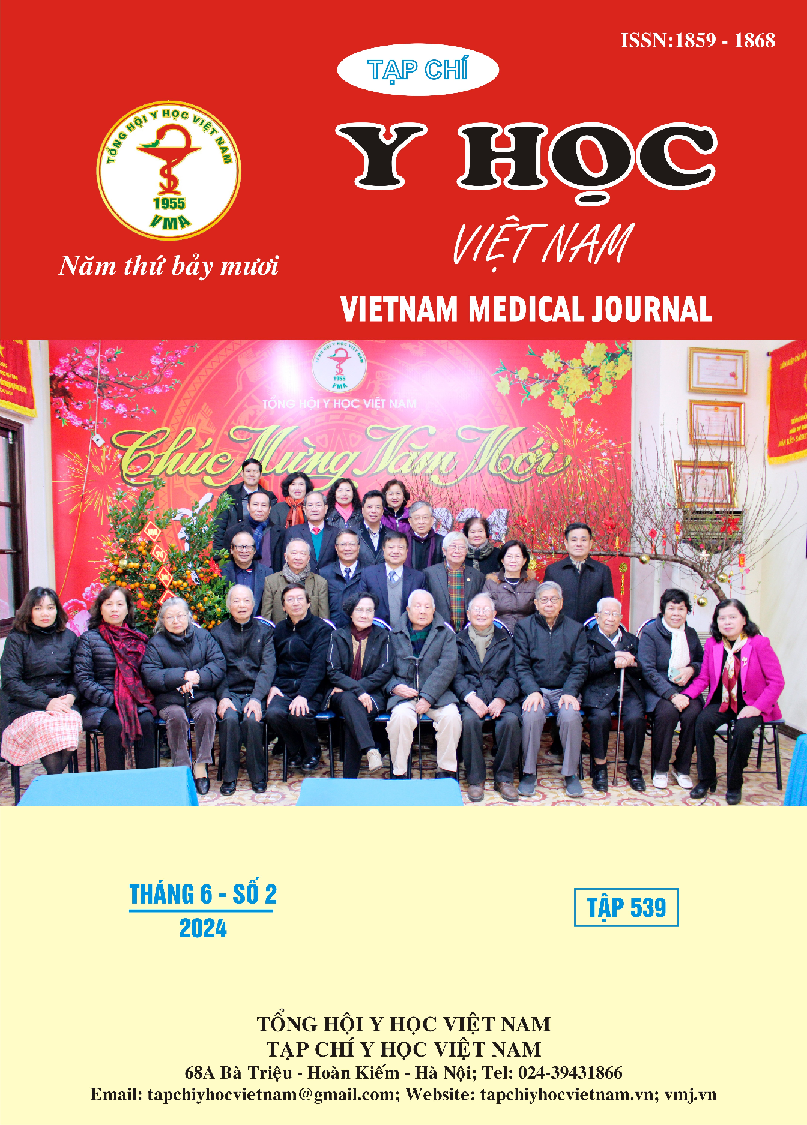SHORT-TERM OUTCOMES OF ANATOMICAL MINOR HEPATECTOMY FOR HEPATOCELLULAR CARCINOMA
Main Article Content
Abstract
Objective: To evaluate the short-term outcomes of anatomical minor hepatectomy for hepatocellular carcinoma (HCC). Subject and method: This was a retrospective descriptive study of the cases who underwent anatomical minor hepatetomy for hepatocellular carcinoma at the Department of Hepatobiliary and Pancreatic Surgery, K Hospital from November 2017 to November 2023. Result: Elective surgery was performed for 127 patients. The average age was 58,4 ± 10,9 years; 86,6% of patients were male; hepatitis B related: 77,2%. The mean AFP was 524,4 ± 1225,2 ng/ml. Portal vein thrombosis was seen in 10 patients (7,9%). The mean tumor size in the CT scan was 4,1 ± 1,9 cm. Right anterior sectionectomy, left latertal sectionectomy and right posterior sectionectomy accounted for 37%, 37% and 26%, respectively. J-shape was the most common incision, with 53,3%. The mean operation time was 133,0 ± 58,8 min. There was no intraoperative blood transfusion. Postoperative complications that occurred in 26 patients (20,5%) including ascites (14,2%), pleural effusion (7,1%), liver failure (3,9%) and surgical site infection (3,1%). The classification of complications according to Clavien was: I (27,6%), II (69,3%) and IIIa (3,1%). There was no perioperative mortality. The average length of hospital stay was 9,5 ± 5,8 days. Conclusion: Anatomical minor hepatectomy for hepatocellular carcinoma is a feasible, safe, and effective method.
Article Details
Keywords
minor hepatectomy, anatomical liver resection, hepatocellular carcinoma.
References
2. Takasaki K (2007), Glissonean pedicle transection method for hepatic resection, Springer Science & Business Media.
3. Menon K V, Al-Mukhtar A, Aldouri A, et al (2006), "Outcomes after major hepatectomy in elderly patients", Journal of the American college of Surgeons, 203 (5), pp. 677-683.
4. Lê Văn Thành (2013), "Nghiên cứu chỉ định và kết quả phẫu thuật cắt gan kết hợp phương pháp Tôn Thất Tùng và Lortat Jacob trong điều trị ung thư biểu mô tế bào gan", Luận án tiến sĩ Y học - Đại học Quân Y.
5. Phạm Thế Anh T H P (2023), "Kết quả gần phẫu thuật cắt gan phân thùy sau có kiểm soát cuống chọn lọc trong điều trị ung thư biểu mô tế bào gan", Tạp chí Y học Việt Nam, 533 (1B), pp. 245-249.
6. Lee C-W, Tsai H-I, Sung C-M, et al (2016), "Risk factors for early mortality after hepatectomy for hepatocellular carcinoma", Medicine, 95 (39).
7. Vũ Văn Quang (2019), "Nghiên cứu ứng dụng kỹ thuật kiểm soát cuống Glisson theo Takasaki trong cắt gan điều trị ung thư biểu mô tế bào gan tại Bệnh viện Trung ương Quân đội 108", Luận án tiến sĩ Y học.
8. Trịnh Quốc Đạt (2019), "Nghiên cứu ứng dụng kỹ thuật kiểm soát chọn lọc cuống Glisson trong cắt gan điều trị ung thư tế bào gan", Luận án Tiến sĩ Y học - Đại học Y Hà Nội.
9. Karamarković A, et al (2016), "Suprahilar Control of Glissonean Pedicle in the Open Anatomic Liver Resections: A Single Centre Experience", ournal of Digestive Cancer Reports, 4 (2), pp. 113-121.
10. Belghiti J, Noun R, Malafosse R, et al (1999), "Continuous versus intermittent portal triad clamping for liver resection: a controlled study", Annals of surgery, 229 (3), pp. 369.


